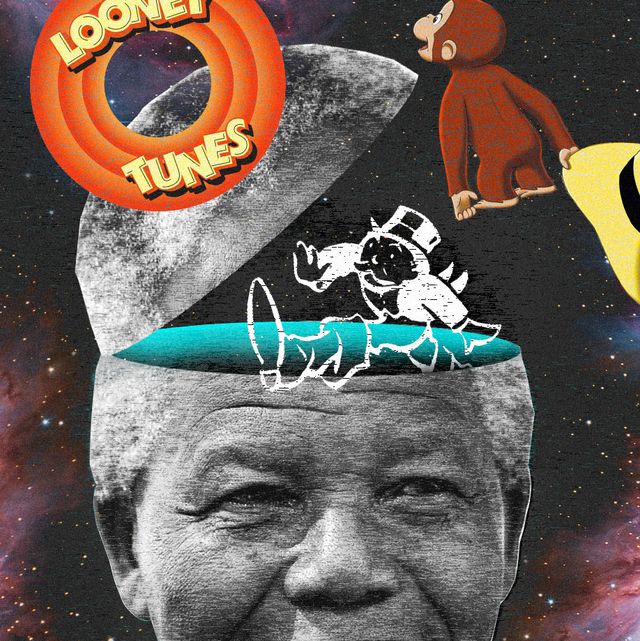In the labyrinthine corridors of our minds, memories are stored like treasured books on a dusty library shelf, waiting to be revisited. These memories shape our perception of reality, but what happens when a multitude of people remember an event differently from the documented truth? Welcome to the baffling realm of the Mandela Effect, a phenomenon that has sparked intense debates, challenging the very fabric of our collective memories. In this article, we’ll embark on a journey through the mysterious world of the Mandela Effect, exploring its origins, examining fascinating examples, and delving into the scientific theories that seek to explain whether it’s a quirk of memory or a portal to alternate realities.
The Curious Case of Nelson Mandela
It all began with a simple yet perplexing question: How could so many people remember Nelson Mandela dying in the 1980s when he actually passed away in 2013? The inexplicable gap between collective memory and historical facts gave birth to what we now call the Mandela Effect. But what exactly is this enigmatic phenomenon?
The Mandela Effect Unveiled
The Mandela Effect is a term coined by Fiona Broome, a self-described “paranormal consultant,” after a peculiar experience she had at a convention. Broome was shocked to learn that many people, including herself, vividly remembered Nelson Mandela, the former President of South Africa, dying in prison in the 1980s. To her surprise, this memory conflicted with the reality that Mandela had been released from prison in 1990 and served as South Africa’s president from 1994 to 1999.
The Mandela Effect is not limited to this single instance. It encompasses a multitude of collective misrememberings, where a significant number of people recall specific events, details, or outcomes differently from what historical records or documented evidence show. While some chalk it up to the quirks of memory, others believe it is a glimpse into the existence of parallel universes or alternate realities.
Part I: Unraveling the Mandela Effect
The Mandela Effect may sound like something out of science fiction, but it has captured the public’s imagination and led to a wide array of examples and theories aimed at explaining its puzzling occurrences. Let’s begin by examining some of the most well-known Mandela Effect examples:
1. The Berenstain Bears Dilemma
For countless individuals, the beloved children’s book series about a bear family is remembered as “Berenstein Bears” with an “e.” However, the actual spelling is “Berenstain” with an “a.” The dissonance between memory and reality has led many to question their own recollections.
2. Curious George’s Missing Tail
Curious George, the mischievous little monkey, is often thought to have a long, curling tail. However, a closer look reveals that George does not have a tail at all. The Mandela Effect suggests that our collective memory adds an appendage that was never there.
3. The Monopoly Man’s Monocle
A popular board game character, the Monopoly Man, is commonly remembered wearing a monocle, but in actuality, he is monocle-less. This widespread misremembering adds to the growing list of Mandela Effect examples.
4. The Color of Chartreuse
Many people recall chartreuse as a shade of pink or reddish color, but it is, in fact, a bright yellow-green hue. This discrepancy between memory and reality raises intriguing questions about the nature of perception.
5. “Luke, I Am Your Father”
Perhaps one of the most iconic movie lines of all time, Darth Vader’s revelation to Luke Skywalker in “Star Wars” is frequently misquoted as “Luke, I am your father.” The actual line is “No, I am your father.” The misquotation demonstrates how popular culture can shape our memories.
6. “Mirror, Mirror on the Wall”
The famous line from “Snow White,” spoken by the Evil Queen, is often remembered as “Mirror, mirror on the wall, who is the fairest of them all?” The actual line is “Magic mirror on the wall, who is the fairest one of all?” This discrepancy exemplifies how collective memory can be influenced by adaptations and parodies.
7. The Location of New Zealand
A peculiar example in geography involves the placement of New Zealand on the map. Many people recall New Zealand being located to the northeast of Australia, but it is actually to the southeast. This collective memory lapse challenges our understanding of spatial orientation.
Part II: Exploring Theories Behind the Mandela Effect
The Mandela Effect, with its myriad examples, has captivated the public’s interest and generated a wide array of theories. These theories attempt to explain why collective memories can be so at odds with documented facts. Let’s dive into some of the most prominent explanations:
1. Misinformation and Pop Culture Influence
One of the simplest explanations for the Mandela Effect is misinformation and the influence of pop culture. In the age of the internet and social media, false information can spread rapidly. When a substantial number of people share and reinforce the same false memory, it can become ingrained in the collective consciousness.
2. Confabulation and Memory Errors
Human memory is a complex and fallible system. Our memories can be influenced by suggestion, external information, and cognitive biases. Confabulation, a phenomenon where individuals fill in gaps in their memory with fabricated information, may contribute to the Mandela Effect.
3. Parallel Universes and Alternate Realities
Some enthusiasts of the Mandela Effect believe it is a consequence of parallel universes or alternate realities. According to this theory, our memories are not incorrect but instead reflect different realities that individuals have experienced. Changes in the fabric of spacetime could create these discrepancies.
4. Quantum Effects and Consciousness
Quantum mechanics, a branch of physics dealing with the behavior of particles at the quantum level, has been invoked to explain the Mandela Effect. Some proponents suggest that quantum effects or changes in consciousness can lead to alterations in reality, affecting the collective memory of events.
5. Psychological Conditioning and False Memories
Psychological conditioning, where individuals are exposed to certain information repeatedly, can lead to the creation of false memories. When a substantial number of people experience the same conditioning, it can result in shared false memories.
6. The Fallibility of Human Perception
Human perception is not a flawless process. Optical illusions, cognitive biases, and the brain’s tendency to fill in gaps in our sensory data can all contribute to the creation of false memories. The Mandela Effect may simply be a manifestation of these perceptual quirks.
Part III: The Mandela Effect – Collective Memory or Alternate Reality?
As we navigate the intriguing world of the Mandela Effect, we encounter a multitude of examples that challenge our understanding of memory, reality, and the nature of human perception. Whether it’s the misspelled “Berenstain Bears,” the misplaced New Zealand, or the misquoted “Luke, I am your father,” the Mandela Effect reminds us that our memories are not infallible.
The explanations for this phenomenon range from the mundane to the extraordinary. While misinformation, memory errors, and cognitive biases offer plausible reasons for collective memory discrepancies, the theories involving parallel universes, quantum effects, and changes in consciousness elevate the Mandela Effect to a level of cosmic significance.
Ultimately, the Mandela Effect raises a fundamental question: Are we simply prone to memory lapses and cognitive imperfections, or could our collective memories be a window into parallel realities and alternate dimensions? The answer remains elusive, and the debate continues.
1. Misinformation and Pop Culture Influence
The simplest explanation for the Mandela Effect is rooted in the widespread dissemination of misinformation. In the age of the internet, social media, and mass communication, falsehoods can spread like wildfire. When a critical mass of people shares and reinforces the same false memory, it can become ingrained in the collective consciousness.
This explanation is grounded in the idea that memory is highly malleable and susceptible to suggestion. The power of suggestion through repeated exposure to incorrect information can lead to the creation of false memories. In essence, the Mandela Effect may arise from the combined influence of the internet, media, and societal narratives.
2. Confabulation and Memory Errors
Human memory, while remarkable in many ways, is also inherently fallible. Our memories can be influenced by suggestion, external information, and cognitive biases. The phenomenon of confabulation, where individuals unknowingly fill in gaps in their memory with fabricated information, is a crucial element to consider in the Mandela Effect.
Confabulation occurs when the brain attempts to reconstruct past events but inadvertently inserts incorrect or imagined details. This reconstruction process can lead to the creation of memories that feel genuine but are, in fact, erroneous. As a result, a large group of people may collectively confabulate and produce shared false memories, contributing to the Mandela Effect.
3. Parallel Universes and Alternate Realities
One of the most intriguing and speculative explanations for the Mandela Effect involves the concept of parallel universes or alternate realities. According to this theory, our memories are not flawed; instead, they reflect different realities or dimensions that individuals have experienced. Changes in the fabric of spacetime could result in these memory discrepancies.
In a multiverse scenario, where multiple universes coexist, each with its unique set of events and outcomes, the Mandela Effect could be the result of individuals tapping into memories from alternate realities. In these parallel universes, historical events and facts may differ, leading to the apparent inconsistency between collective memories and the documented reality.
4. Quantum Effects and Changes in Consciousness
Quantum mechanics, a realm of physics that delves into the behavior of particles at the quantum level, has also been invoked to explain the Mandela Effect. Some proponents of this theory suggest that quantum effects or shifts in consciousness can result in changes to the very nature of reality, thereby influencing collective memory.
In this view, the Mandela Effect is a manifestation of quantum phenomena at the macroscopic level. Changes in the quantum states of particles could ripple through the fabric of spacetime, altering historical events, and subsequently, our collective recollection of those events.
5. Psychological Conditioning and False Memories
Psychological conditioning is another plausible explanation for the Mandela Effect. When individuals are repeatedly exposed to specific information, they can develop false memories that align with that information. If a substantial number of people undergo this conditioning, shared false memories may emerge.
The concept of cognitive priming, where exposure to particular information or stimuli influences subsequent perceptions and memories, plays a significant role in this theory. It demonstrates how the mind can be shaped and conditioned to recall events or details differently, contributing to the Mandela Effect.
6. The Fallibility of Human Perception
Human perception is a fascinating yet imperfect process. Optical illusions, cognitive biases, and the brain’s innate tendency to fill in gaps in sensory data all play a role in shaping our understanding of the world. The Mandela Effect may simply be a manifestation of these perceptual quirks.
Cognitive biases, in particular, can lead individuals to perceive and remember information in specific ways. For example, confirmation bias can cause people to search for and remember information that confirms their existing beliefs, even if those beliefs are incorrect. Similarly, the availability heuristic can lead people to recall more recent or emotionally charged events more vividly, overshadowing less salient memories.
Part IV: The Quest for Understanding
The Mandela Effect may never be fully explained to the satisfaction of all. However, it serves as a compelling reminder of the complexities of human memory, perception, and the enduring mysteries of the human experience. Whether you lean toward scientific explanations or are drawn to the mystical allure of parallel universes, the Mandela Effect invites us to explore the boundaries of what we know and what may forever elude our grasp.
As we contemplate the curious case of the Mandela Effect, we are reminded that the human mind is a vast, uncharted landscape, capable of perceiving and misperceiving the world in intriguing ways. Whether it’s a collective memory or a glimpse into alternate realities, the Mandela Effect keeps us questioning, searching, and wondering about the mysteries that surround us.

